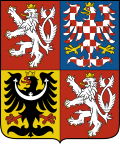Movement for Autonomous DemocracyâParty for Moravia and Silesia HnutĂ za samosprĂĄvnou demokracii - SpoleÄnost pro Moravu a Slezsko | |
|---|---|
 | |
| Leaders |
Boleslav BĂĄrta Jan KryÄer |
| Founded | 1990 |
| Dissolved | 1996 |
| Merged into |
Bohemian-Moravian Centre Union |
| Newspaper | MoravskoslezskĂĄ orlice |
| Ideology |
Federalism Moravian autonomism |
| Political position | Centre |
| Colours | Gold, Red |
 |
|---|
|
|
The Movement for Autonomous DemocracyâParty for Moravia and Silesia ( Czech: HnutĂ za samosprĂĄvnou demokraciiâSpoleÄnost pro Moravu a Slezsko, HSDâSMS) was a political party in Czechoslovakia and the Czech Republic that sought autonomy for Moravia. [1]
History
The party was established on 4 April 1990, and was initially led by Boleslav BĂĄrta. [2] In the elections to the Czechoslovakian Federal Assembly in June it won nine seats in the Chamber of the People and seven in the Chamber of the Nations. In the simultaneous elections to the National Council of the Czech Republic the party won 23 seats, making it the third largest party in the Council. [3] The party was part of Petr Pithart's coalition government between 1990 and 1992. [4] BĂĄrta died in 1991 and was replaced by Jan KryÄer. [2]
In the federal elections in 1992 the party lost all its seats in both chambers of the Federal Assembly, whilst the Czech elections saw it reduced to 14 seats. [3]
In 1993 the party was renamed the Movement for Self-Governing Democracy of Moravia and Silesia (HnutĂ samosprĂĄvnĂ© demokracie Moravy a Slezska). [2] After the liberal wing of the party came to power the following year, the party became the Moravian Centre Party (Äeskomoravskou stranu stĆedu). In December 1994 it formed an alliance with the Liberal-Social Union and the Agrarian Party named the Moravian Centre Union, and formally merged into a single political party in February 1996. [2] The new party failed to win a seat in the 1996 elections. [3]
Election results
Czech National Council
| Year | Vote | Vote % | Seats | Place | Govt? |
|---|---|---|---|---|---|
| 1990 | 723,609 | 7.03 | 22 / 200
|
3rd | Yes |
| 1992 | 380,088 |
5.87 |
14 / 200
|
8th |
No |
Local Elections
| Year | Vote | Vote % | Seats |
|---|---|---|---|
| 1990 | 3,200,022 | 4.16 | 1,706 |
| 1994 | 563,674 |
0.44 |
372 |
References
- ^ Libor Musil, Ladislav Rabusic and Petr Mares (1991) "Is the Moravian Movement the last straw which the Moravians grasp?" Studia Minora Facultatis Philosophicae Universitatis Brunensis
- ^ a b c d Rise and Fall of Moravian Regionalist Parties Central European Political Studies Review
- ^ a b c Dieter Nohlen & Philip Stöver (2010) Elections in Europe: A data handbook, p490â492 ISBN 978-3-8329-5609-7
- ^ Czech Republic Parties and Elections
Movement for Autonomous DemocracyâParty for Moravia and Silesia HnutĂ za samosprĂĄvnou demokracii - SpoleÄnost pro Moravu a Slezsko | |
|---|---|
 | |
| Leaders |
Boleslav BĂĄrta Jan KryÄer |
| Founded | 1990 |
| Dissolved | 1996 |
| Merged into |
Bohemian-Moravian Centre Union |
| Newspaper | MoravskoslezskĂĄ orlice |
| Ideology |
Federalism Moravian autonomism |
| Political position | Centre |
| Colours | Gold, Red |
 |
|---|
|
|
The Movement for Autonomous DemocracyâParty for Moravia and Silesia ( Czech: HnutĂ za samosprĂĄvnou demokraciiâSpoleÄnost pro Moravu a Slezsko, HSDâSMS) was a political party in Czechoslovakia and the Czech Republic that sought autonomy for Moravia. [1]
History
The party was established on 4 April 1990, and was initially led by Boleslav BĂĄrta. [2] In the elections to the Czechoslovakian Federal Assembly in June it won nine seats in the Chamber of the People and seven in the Chamber of the Nations. In the simultaneous elections to the National Council of the Czech Republic the party won 23 seats, making it the third largest party in the Council. [3] The party was part of Petr Pithart's coalition government between 1990 and 1992. [4] BĂĄrta died in 1991 and was replaced by Jan KryÄer. [2]
In the federal elections in 1992 the party lost all its seats in both chambers of the Federal Assembly, whilst the Czech elections saw it reduced to 14 seats. [3]
In 1993 the party was renamed the Movement for Self-Governing Democracy of Moravia and Silesia (HnutĂ samosprĂĄvnĂ© demokracie Moravy a Slezska). [2] After the liberal wing of the party came to power the following year, the party became the Moravian Centre Party (Äeskomoravskou stranu stĆedu). In December 1994 it formed an alliance with the Liberal-Social Union and the Agrarian Party named the Moravian Centre Union, and formally merged into a single political party in February 1996. [2] The new party failed to win a seat in the 1996 elections. [3]
Election results
Czech National Council
| Year | Vote | Vote % | Seats | Place | Govt? |
|---|---|---|---|---|---|
| 1990 | 723,609 | 7.03 | 22 / 200
|
3rd | Yes |
| 1992 | 380,088 |
5.87 |
14 / 200
|
8th |
No |
Local Elections
| Year | Vote | Vote % | Seats |
|---|---|---|---|
| 1990 | 3,200,022 | 4.16 | 1,706 |
| 1994 | 563,674 |
0.44 |
372 |
References
- ^ Libor Musil, Ladislav Rabusic and Petr Mares (1991) "Is the Moravian Movement the last straw which the Moravians grasp?" Studia Minora Facultatis Philosophicae Universitatis Brunensis
- ^ a b c d Rise and Fall of Moravian Regionalist Parties Central European Political Studies Review
- ^ a b c Dieter Nohlen & Philip Stöver (2010) Elections in Europe: A data handbook, p490â492 ISBN 978-3-8329-5609-7
- ^ Czech Republic Parties and Elections